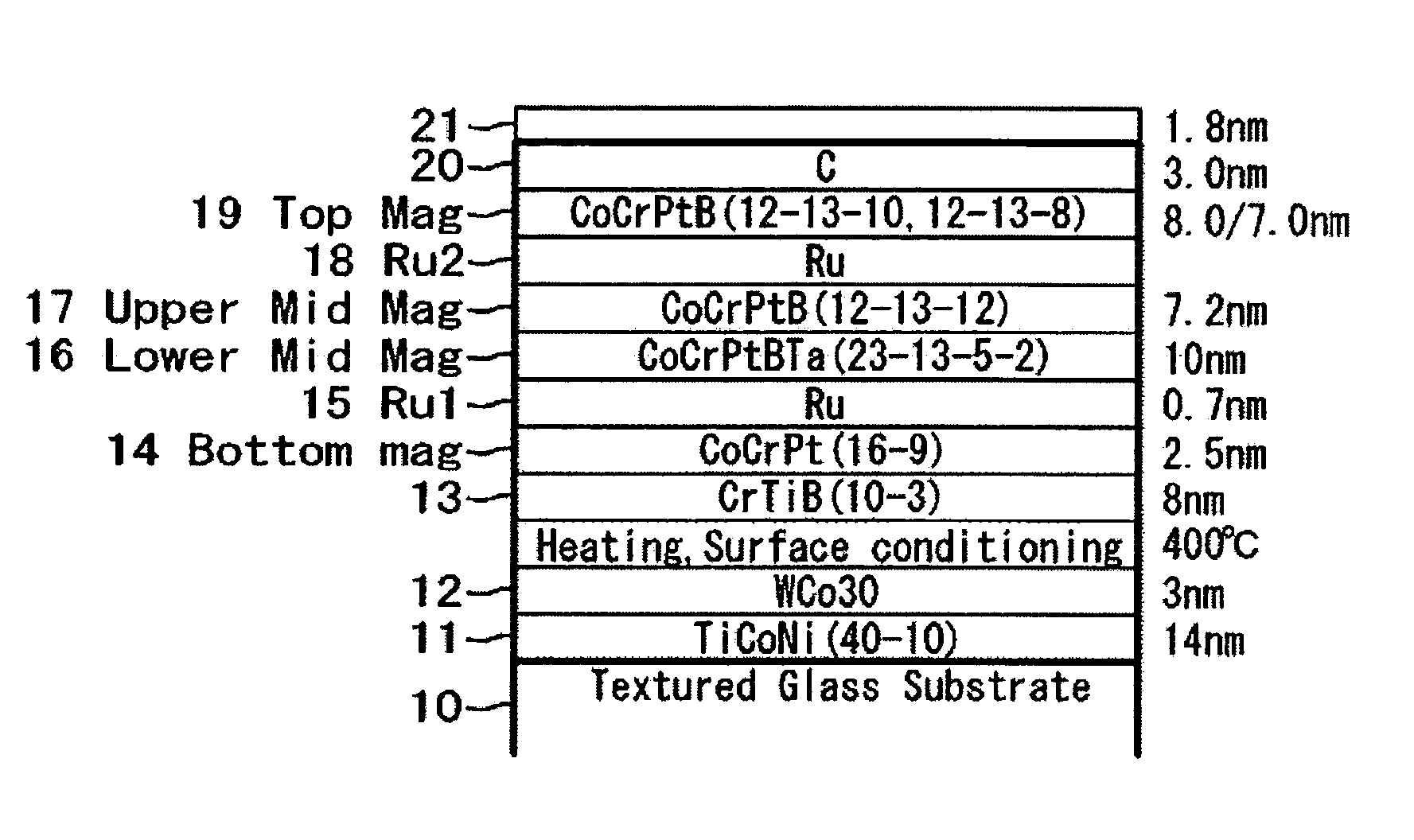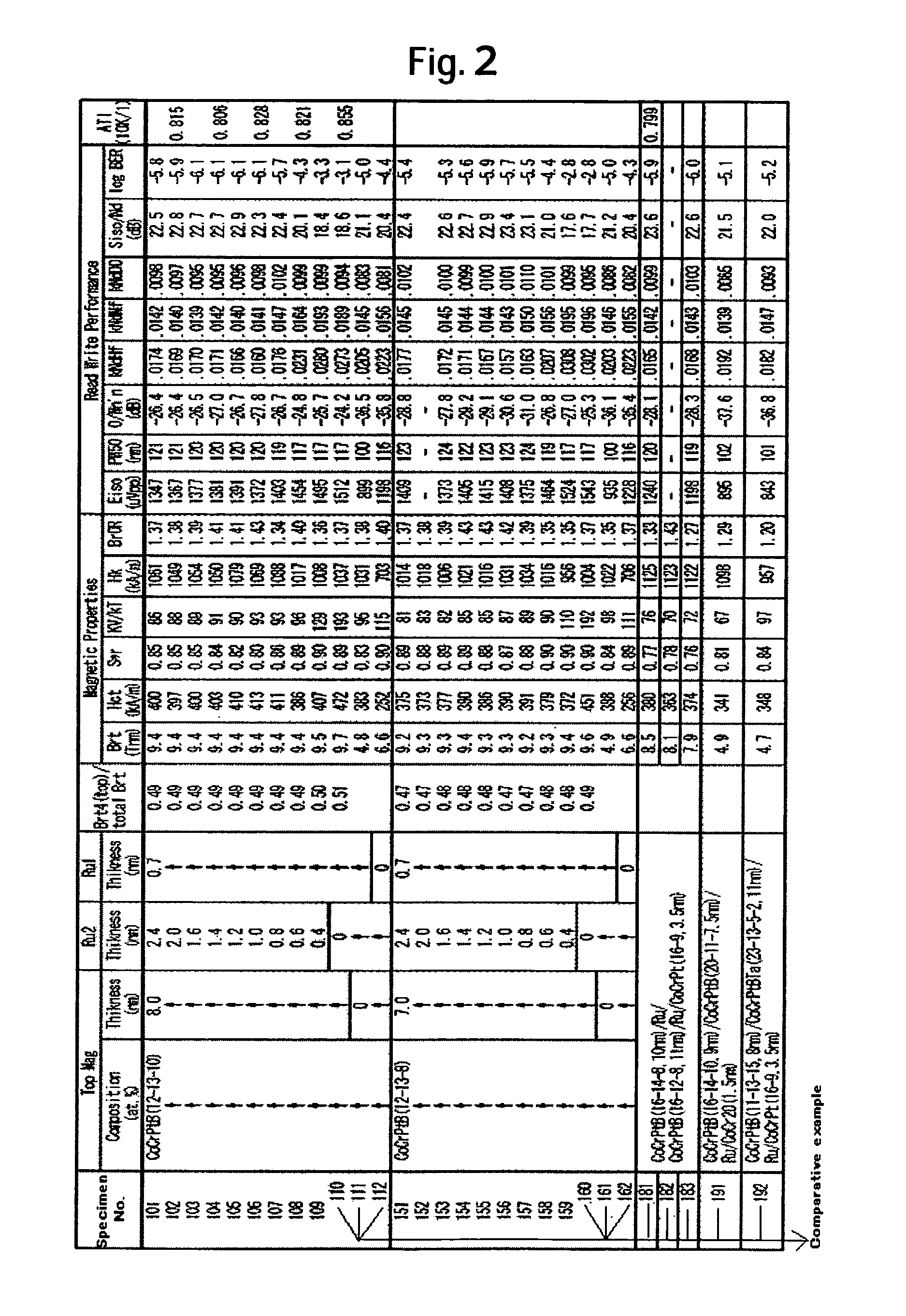Magnetic recording medium for high density recording
a recording medium and high density technology, applied in the field of magnetic recording medium, can solve the problems of limited noise reduction and thermal stability degradation, and achieve the effects of reducing the aging change caused by thermal fluctuation and improving the bit error ra
- Summary
- Abstract
- Description
- Claims
- Application Information
AI Technical Summary
Benefits of technology
Problems solved by technology
Method used
Image
Examples
embodiment 1
[0029]FIG. 1 shows a cross sectional structure of Embodiment 1 of a magnetic recording medium of the present invention. An aluminosilicate glass substrate 10 chemically reinforced at the surface was put to alkali cleaning. After drying, an argon (Ar) gas was introduced in vacuum, and a Ti-40 at. % Co-10 at. % Ni alloy formed by adding 40 atomic % (hereinafter referred to as at. %) cobalt and 10 at. % nickel to titanium of 14 nm thick as a first underlayer 11, and a W-30 at. % Co alloy layer of 3 nm thick comprising tungsten (W) as a main component as a second underlayer were formed by a DC magnetron sputtering method at room temperature. Then, after heating the substrate to reach a temperature of about 400° C. in an atmosphere with residual gas being controlled by a lamp heater, a Cr-10 at. % Ti-3 at. % B alloy of 10 nm thick was formed as a third underlayer 13. Further, a first magnetic layer 14 of 2.5 nm thick comprising a Co-14 at. % Cr-6 at. % Pt alloy, a first non-magnetic inte...
embodiment 2
[0046]FIG. 7 shows a constitutional cross-sectional view of a medium examined in this embodiment. A magnetic recording medium was formed in the same manner as in Embodiment 1 except that the following conditions were changed among the conditions for manufacturing Embodiment 1.
[0047](1) To control the coercivity, the heating temperature for the substrate was used as a variant, which was controlled from 350° C. to 390° C.
[0048](2) The thickness of Ru formed as the first intermediate layer was set to about 0.5 nm.
[0049](3) The thicknesses of the second magnetic layer and the third magnetic layer were changed.
[0050](4) The composition and the thickness of the fourth magnetic layer were changed.
[0051](5) The thickness of Ru formed between the third magnetic layer and the fourth magnetic layer was fixed at about 0.6 nm.
[0052]A combination of the thickness for the second magnetic layer (Co-22 at. % Cr-14 at. % Pt-6 at. % B-2 at. % Ta) and the third magnetic layer (Co-12 at. % Cr-13 at. % P...
embodiment 3
[0059]FIG. 10 shows a constitutional cross-sectional view of a medium examined in this embodiment. A magnetic recording medium is formed in the same manner as in Embodiment 2 except that the following conditions are changed among the conditions for manufacturing Embodiment 2.
[0060](1) The composition and thickness of the third magnetic layer are changed.
[0061](2) The fourth magnetic layer is fixed to a Co-12 at. % Cr-13 at. % Pt-10 at. % B alloy.
[0062]The thickness of the second magnetic layer: Co-22 at. % Cr-14 at. % Pt-6 at. % B-2 at. % Ta included two types of 11.7 nm and 10.6 nm. As the composition for the third magnetic layer, Co-8 at. % Cr-13 at. % Pt-12 at. % B, Co-10 at. % Cr-13 at. % Pt-12 at. % B, Co-12 at. % Cr-13 at. % Pt-12 at. % B, Co-14 at. % Cr-13 at. % Pt-12 at. % B, Co-12 at. % Cr-13 at. % Pt-10 at. % B, and Co-12 at. % Cr-13 at. % Pt-14 at. % B were examined.
[0063]FIG. 11 shows the relationship between the magnetic characteristic and electromagnetic conversion cha...
PUM
| Property | Measurement | Unit |
|---|---|---|
| thickness | aaaaa | aaaaa |
| thickness | aaaaa | aaaaa |
| thick | aaaaa | aaaaa |
Abstract
Description
Claims
Application Information
 Login to View More
Login to View More - R&D
- Intellectual Property
- Life Sciences
- Materials
- Tech Scout
- Unparalleled Data Quality
- Higher Quality Content
- 60% Fewer Hallucinations
Browse by: Latest US Patents, China's latest patents, Technical Efficacy Thesaurus, Application Domain, Technology Topic, Popular Technical Reports.
© 2025 PatSnap. All rights reserved.Legal|Privacy policy|Modern Slavery Act Transparency Statement|Sitemap|About US| Contact US: help@patsnap.com



